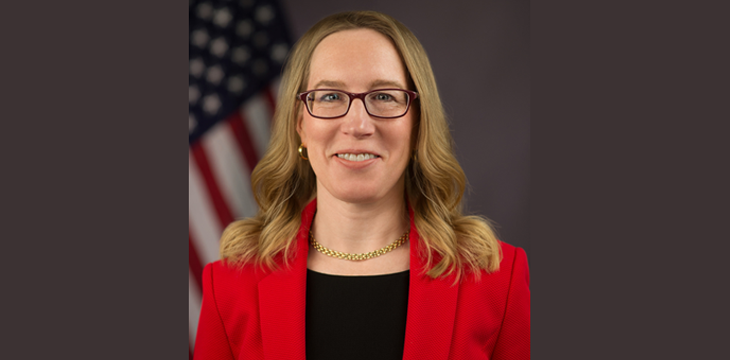|
Getting your Trinity Audio player ready...
|
As the regulatory landscape for digital assets continues to take shape, regulators worldwide are getting to grips with the ins and outs of the specific needs of the blockchain and digital currency industries.
In the latest episode of Blockchain Policy Matters, Bitcoin Association Founding President Jimmy Nguyen caught up with SEC Commissioner Hester Peirce to discuss the current regulatory picture.
It was a pleasure speaking with SEC Commissioner @HesterPeirce about #digitalasset regulation & how to bring more clarity to support innovation; token offerings; DeFi; NFTs; + more.
WATCH this episode of #Blockchain Policy Matters – from @BitcoinAssn https://t.co/OwIMI8TSXK
— Jimmy Nguyen (@iamJimmyWIN) March 18, 2021
Peirce was nominated by U.S. President Donald Trump in July 2017 as a Commissioner to the Securities and Exchange Commission and confirmed by the Senate later that year, beginning the balance of a five-year term in January 2018. She has come to be affectionately known in the digital currency industry as “Crypto-Mom,” for her proactive approach to regulation in the sector.
Rather than focusing clamping down on the sector through regulation – almost certainly at the cost of innovation – Peirce explained that she takes the view that it is in everyone’s interests to look at how regulation can help encourage innovation and growth in the sector.
“What I would urge my fellow regulators to think about is to think not only to have the reaction of looking at where the negatives are, but to really look for the positives. So if the Fed is considering a CBDC [central bank digital currency] – that may be something they want to do in terms of an infrastructure project – I would hope they don’t rule out the positive things that can happen in the purely private sector as well.”
She noted, “Remember that a lot of the real innovation happens in the private sector—don’t try to squelch that out, and don’t view this as a competition between the private and the public sector. I think you can have a public CBDC, but you can also have a lot of this stuff happening on the private side. There tends to be a conservatism—which I think is reflected in a lot of comments from regulators—but look at it optimistically too; look at the potential for technology to change things for the better for everyone. I don’t think we win out as regulators when we try to prevent innovation from happening or try to shift it outside of the United States. That will ultimately not serve us well.”
On government applications coexisting alongside private sector innovations in blockchain, Peirce told Nguyen that there is still progress to be made in figuring out the best synergies between the two.
“It’s early days in terms of trying to figure that out. You can think of financial and non-financial uses. From a securities regulator perspective, I think about how blockchain can assist us in making more efficient some of the processes that came to light over the past couple of months, as we’ve been thinking about things like the rise of the meme stocks and some of the concerns of settlement stocks, things like that,” she said.
“I hope that a lot of that innovation happens in the private sector as opposed to us taking it over as a securities regulator. I think the benefit of some of these distributed ledger-type innovations is that it does contribute to resiliency by taking away common central points of failure that everyone is using. So to the extent we can use this technology to enhance the resiliency of our financial system, I think we will be better off.”
Addressing safe harbors, Peirce said the idea was attractive as a way of providing a level playing field for everyone innovating in the sector.
“I think the thing that drove me to think about a safe harbor is just this idea of wanting to provide a level playing field so that anyone could take advantage of it on the same terms as anyone else,” Peirce explained.
“The idea is that if you’ve spent a considerable amount of time and money developing a project and you’re ready to launch your network and you want to get the tokens out into the hands of people who can actually use them, it really is a concern about how you could do that consistent with the law. This would allow you to not have to really answer whether that token distribution event wasn’t a security offering or not. Instead, you would make the disclosures prescribed in the safe harbor, which are intended to get to the things that token purchasers would be interested in knowing.”
Peirce went on to suggest the SEC needs to be giving clear guidance to industry now, rather than in retrospect, in order to better support growth and innovation.
“What I’m concerned about is that we can’t wait three years to go back and say, OK, well, this is what you did. And this is how it violated the securities laws. If we’re seeing things now when we really need to be telling people now, this is what you need to bear in mind as you’re as you’re engaging in this activity.”
You can find episode two of Blockchain Policy Matters on the Bitcoin Association YouTube channel.

 12-27-2025
12-27-2025 




